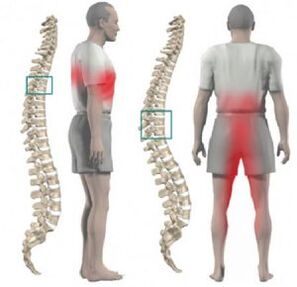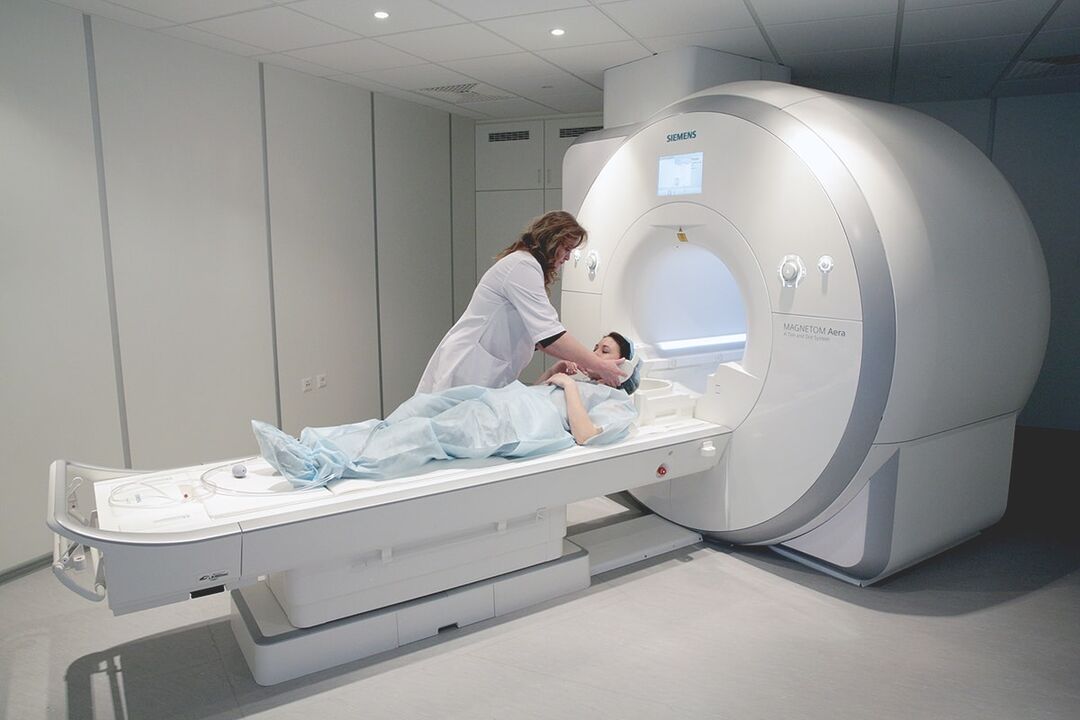The disease-chameleon is often called osteochondrosis of the chest. It is quite difficult to diagnose, it is often confused with other diseases. At the same time, osteochondrosis rarely occurs in the thoracic region and is a lesion of the intervertebral discs.
How does disease occur?

Osteochondrosis, which affects the thoracic spine, is often disguised as a pathology of internal organs. It is manifested by pain in the heart, shortness of breath, a feeling of lack of air when inhaling, panic attacks. Therefore, the diagnosis of thoracic osteochondrosis is somewhat difficult.
The intervertebral discs of each spine consist of the nucleus pulposus and the stronger annulus fibrosus. The latter protects the semi-liquid core and prevents it from being damaged.
However, for certain reasons, there are situations when the metabolic processes slow down and as a result there is increased pressure on the discs. In this case, the disk is deformed, its structure is disturbed.
If treatment is not started at this stage, the symptoms become more pronounced. The annulus fibrosus may crack and the nucleus dry out.
The disease leads to injury of spinal nerves, destruction of joints.
Causes of disease
Various reasons can cause the appearance of osteochondrosis in the thoracic region, and the most common among them are:
- chest trauma;
- inactivity, sedentary work (refers to those who work at a computer or are drivers);
- scoliosis.
In addition, problems with the thoracic region are related to its structure. In this interval of the spine, there are many more discs packed than in the lower back or the neck. Due to the presence of ribs and muscular corset, the thoracic region moves less.
There are cases when the main cause of osteochondrosis in the thoracic spine is osteochondrosis of other departments.
What is the danger of osteochondrosis?
If, despite the symptoms, treatment is delayed, osteochondrosis in the thoracic region can lead to numerous complications and problems, including:
- intercostal neurology - when the intercostal nerves are compressed;
- spinal cord compression;
- difficulty breathing, heart problems;
- problems with bowel, liver, kidney function;
- stool problems;
- hernia.
What diseases can be confused with osteochondrosis?
As mentioned above, the symptoms of osteochondrosis do not always allow a quick diagnosis. That is why osteochondrosis of the chest can be accidentally confused with:
- mammary gland pathologies;
- diseases of the digestive system;
- pneumonia (the two diseases can be distinguished by a dry cough, shortness of breath and fever with pneumonia. In the case of osteochondrosis, such symptoms are not observed);
- heart attack (in this case, osteochondrosis can be distinguished through a cardiogram);
- renal colic.
Symptoms
In the case of osteochondrosis of the thoracic region, symptoms of radiculopathy most often appear, that is, those associated with compression of the nerve trunks and the appearance of a hernia between the vertebrae. In this case, severe pain manifests itself after physical work, training. Symptoms in the following weeks become more pronounced, depending on the location of the hernia. If it is in the upper part, then the liver, heart, stomach suffer. If it is lower, then the problems are related to the kidneys.

The location of the hernia also has a significant impact on symptoms. Therefore, if it is located closer to the middle, the pain becomes stronger, continues for several weeks continuously and does not decrease after taking medication. Lateral hernia is manifested by periodic and mild pain, local loss of sensitivity is possible.
Osteochondrosis of the chest, which is accompanied by compression of the spinal cord, has the following symptoms:
- severe pain;
- numbness of limbs;
- the pain radiates to the stomach, groin, legs;
- pelvic organ dysfunction.
In addition to the above, osteochondrosis can manifest additional symptoms, in particular:
- numbness of certain areas of the skin;
- feeling of "goosebumps" in the thoracic spine;
- fragility of nails;
- dry skin, peeling;
- disorders of the gastrointestinal tract (diarrhea or, conversely, constipation);
- causing a sore throat;
- itching or feeling cold in the lower extremities.
Dorsago as a consequence of osteochondrosis of the thoracic region
Osteochondrosis in the thoracic spine is characterized by the presence of dorsag. This is one of its main symptoms. In fact, the word "dorsago" should be understood as a very strong and sudden pain in the chest. It is often called "shooting" because the sensations in this case are the same as in a stab wound. A strong attack of dorsag makes it difficult to breathe and prevents free movement. This happens after long-term physical exertion in people who already suffer from osteochondrosis and joint diseases.
Slight, but growing and long-lasting pain in the thoracic region is called dorsalgia. More pronounced symptoms when a person bends down. The pain can also increase at night, especially often in women suffering from osteochondrosis who wear high-heeled shoes.
Diagnostics
In case of thoracic osteochondrosis, it is necessary to carry out effective treatment. Symptoms without it will only intensify and interfere with normal life.

After determining the symptoms, the doctor refers the patient to an additional examination. Among the diagnostic methods most often used for osteochondrosis of the thoracic region are:
- MRI. The tomograph allows obtaining a clear three-dimensional image with contrast of the area of the human body being studied. Therefore, the doctor can see the condition of the vertebrae of the thoracic region, assess the health of the joints. The procedure does not take much time (from 20 to 55 minutes) and is painless. The patient should expose the thoracic spine and lie on a special couch. The scanner, which is placed on the person, is currently photographing the sections.
- Ultrasound procedure. Before carrying out treatment, it is worth making sure that osteochondrosis of the thoracic region is not accompanied by tumors. The ultrasonic method is suitable for this. The device clearly shows the condition of soft tissues, joints, intervertebral discs. As in the first case, the procedure does not take much time and is painless. With the help of an ultrasound examination, the thoracic region of pregnant women and even children can be examined.
Of course, the doctor does not offer any therapy until the patient passes general clinical blood and urine tests, as well as until the results of the electrocardiogram are available. The latter allows the doctor, with similar symptoms, to distinguish osteochondrosis of the chest from a heart attack or other heart problems.
Treatment
Addressing a neuropathologist, a patient with thoracic osteochondrosis will receive the recommended therapy. Methods and drugs, as well as the duration of their use, are determined by the doctor in each individual case. As a rule, when osteochondrosis is detected in the chest, doctors recommend:
- drug treatment - its goal is to relieve pain, muscle spasms, reduce the inflammatory process, restore tissues around the joints and vertebrae;
- physiotherapy - aims to use ultrasound waves, electric current or laser to relieve sharp pains in the thoracic region and reduce the negative effects of osteochondrosis, provides joint treatment;
- manual therapy - thanks to the specialist's massage movements, it is possible to align the position of the discs of the thoracic region, relieve spasm;
- isometric kinesiotherapy (treatment with gymnastics) - helps to improve the mobility of the thoracic region, relieves pain.
In addition to the methods described above, the treatment of osteochondrosis can be carried out with hirudotherapy, millimeter wave therapy, apitherapy, magnetotherapy and other methods.



















